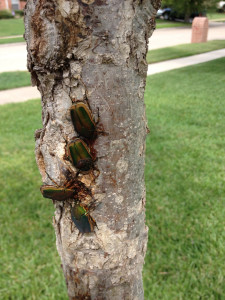This past week I’ve had several inquiries about large, green beetles hanging out around trees. These have all turned out to be the green June beetle, Cotinus nitida.
The green June beetle is a large beetle (3/4 inch to 1 inch-long) related to the infamous June beetle or Junebug–the larval form of which is the white grub pest of lawns. Unlike it’s cousin, the green June beetle is mostly harmless in urban landscapes, unless you happen to own a fig or peach tree.
Green June beetle larvae feed principally on compost, manure or other decaying vegetable matter. The adults feed on leaves and fruits of various fruit and vegetable crops. They are especially fond of thin-skinned fruits like figs, grapes, blackberries, raspberries, peaches, pears, plums, apples, and corn. For more information about green June beetles as pests of crops see Extension publication EEE-00044.
The adult green June beetle is a pretty, velvety green, especially on the shield behind the head (prothorax) and its wing covers. The lower body surface and the edge of the prothorax and wing covers are yellowish-orange. The larva looks like any other white grub (scarab) beetle larva, but can be larger, reaching almost an inch in length when fully developed. It has an unusual behavior of emerging from the soil at night and crawling around on its back. The tunneling behavior of the larva is the other troublesome feature of this beetle. In lawns, the larvae may produce mounds of soil, similar in appearance to ant mounds. In vegetable gardens, their aggressive tunneling may damage the roots of plant.
Soils with lots of compost amendments, or where manure has been incorporated as fertilizer, are most attractive to egg-laying adult beetles. In urban lawns, larval burrows are most commonly seen close to compost piles or organically amended soils.
If you see green June beetles attracted to a (non-fruit bearing) tree in your yard there should be little cause for alarm. Adult beetles are attracted to sap and may be seen clustered on trunks where sap is oozing. They do not cause the sap to ooze, but are readily attracted to fermentation odors of the sap. Many trees are oozing sap this summer from bacterial flux or other borers. But don’t blame the pretty green June beetle.
